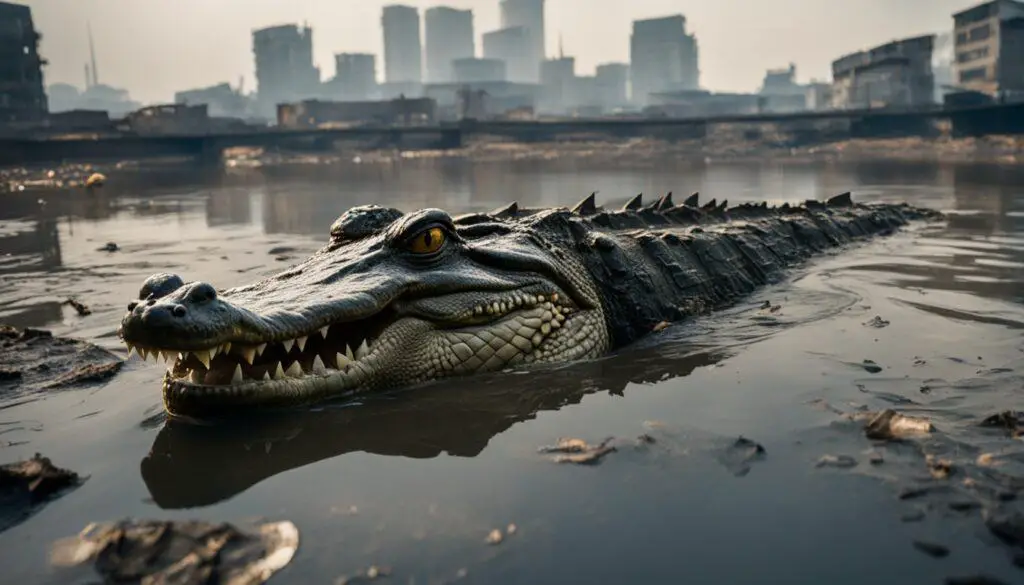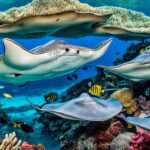Crocodile conservation is now a top priority due to threats in our fast-changing world. You might ask, are crocodiles endangered? It’s vital to know their conservation status to understand why we need to protect them. We’ll explore crocodile species, where they live, and what threats they face.
Understanding Crocodile Species and Distribution
The world of crocodilians is filled with a wide variety of species, each living in its own special way. It’s important to understand the crocodilian diversity to see how these reptiles fit into their environments. These ancient creatures have special traits that help them live in different places all over the world.
Overview of Crocodilian Diversity
There are 25 different kinds of crocodilians, including alligators, caimans, and gharials. Each one is unique in size, shape, and behavior. For example, the American alligator is big and can live in many places, while the gharial has a long snout for catching fish. Their looks often tell us about what they eat, how they have babies, and how they live with others.
Global Distribution of Crocodile Species
The global distribution of crocodile species shows how well these reptiles can adapt to different places. They live in many kinds of environments, like rivers, wetlands, and coastlines. You can find them in countries across North America, Africa, Asia, and Australia. Each place has its own special way of supporting these reptiles.
| Species | Habitat | Distribution |
|---|---|---|
| American Alligator | Freshwater swamps, rivers | USA, parts of Mexico |
| Saltwater Crocodile | Coastal areas, rivers | Tropical regions worldwide |
| Orinoco Crocodile | Freshwater systems | Venezuela, Colombia |
| Gharial | Riverine habitats | India, Nepal |
| Spectacled Caiman | Lakes, rivers | Central and South America |
Crocodile Conservation Status Overview
Understanding the conservation status of crocodiles is key to their well-being. The IUCN Red List is a vital tool for this. It shows which species need help and what threats they face.
Current Status on the IUCN Red List
The IUCN Red List’s latest updates give us important insights. Right now, 7 species are Critically Endangered, 1 is Endangered, 3 are Vulnerable, and 14 are Least Concern. These numbers show the big challenges these reptiles face. They highlight the need for strong conservation efforts.
Categories of Endangerment
The IUCN Red List’s endangerment categories are crucial for conservation plans. They help us know which species need urgent help. Knowing these categories helps us spread the word and take action for crocodile conservation. The main categories are:
- Critically Endangered: Species facing an extremely high risk of extinction in the wild.
- Endangered: Species at a very high risk of extinction in the wild.
- Vulnerable: Species facing a high risk of extinction in the wild.
- Least Concern: Species that are widespread and abundant, thus at a lower risk of extinction.
Are Crocodiles Endangered?
Figuring out if crocodiles are endangered takes a close look at several factors. We need to check how different things affect their numbers. This is key for saving these amazing reptiles.
Criteria for Endangerment Assessment
When we check if crocodiles are endangered, we look at a few things:
- Population Size: How many crocodiles are left in the wild is very important.
- Habitat Degradation: They need certain habitats to survive. Losing their homes, like wetlands and rivers, is a big problem.
- Threats from Human Activity: Humans harm them through poaching, pollution, and more.
Highlighted Endangered Crocodile Species
Two endangered crocodile species show why we need to act fast:
- Philippine Crocodile: This crocodile is in big trouble because of lost homes and hunting. There are less than 250 left in the wild, so we must act quickly.
- Orinoco Crocodile: Once common in Colombia and Venezuela, now it’s in big trouble. Conservation efforts are trying, but it’s tough.

Threats to Crocodile Survival
Crocodiles face many challenges that threaten their survival. It’s crucial to understand these threats to help conservation efforts. By knowing the main threats, we can work towards saving these creatures.
Habitat Loss and Degradation
Urban development, agriculture, and logging lead to crocodile habitat loss. These changes make it hard for crocodiles to live. They need wetlands and rivers for nesting, food, and shelter.
When these places change, crocodiles struggle to survive. This means fewer places to nest and find food, which is a big danger to their numbers.
Impact of Climate Change
Climate change greatly affects crocodile habitats. Warmer temperatures and unpredictable weather mess with their breeding and food. Rivers and lakes change, making less space for crocodiles.
This forces them to move to places that are not as good for them. It also means more competition for resources, making survival harder.
Human Interaction and Poaching
Humans pose a big threat to crocodiles. Poachers hunt them for their skin and meat. Humans moving into their territory leads to conflicts, harming their homes.
This, along with more cities, puts a lot of pressure on crocodile populations. It’s a big challenge for their survival.
| Threat Type | Description | Impact on Crocodiles |
|---|---|---|
| Habitat Loss | Urban development, agriculture, logging | Decreased nesting sites and food sources |
| Climate Change | Rising temperatures, altered weather patterns | Disruption of breeding and resource availability |
| Human Interaction | Poaching, urban encroachment | Population decline and conflict |
Crocodile Population Decline Factors
The decline of crocodile populations is a complex issue. Pollution and illegal trade are major factors. It’s crucial to understand these threats to save these ancient reptiles.
Effects of Pollution on Crocodile Habitats
Pollution is a big threat to crocodile habitats. Chemicals from farms and factories harm the water, making it hard for crocodiles to live. This hurts their breeding spots and health, leading to fewer crocodiles.
As their homes get worse, crocodiles face a tough fight to survive. We need to act fast to make their habitats better.
Overexploitation in Illegal Trade
Illegal trade is another big problem for crocodiles. People want their skins and body parts, leading to too many being taken from the wild. This not only harms the species but also reduces their genetic diversity.
It’s important to protect wildlife laws and teach people about the issue. This can help stop the illegal trade and save crocodile populations.
FAQ
Are crocodiles considered endangered species?
Yes, many crocodile species are endangered or critically endangered. This is because of habitat loss, poaching, and other threats.
What are the main reasons for crocodile population decline?
The main reasons include losing their homes to human development, pollution, and illegal trade. These activities harm their breeding grounds and survival.
How many species of crocodilians exist globally?
There are 25 recognized species of crocodilians worldwide. This includes alligators, caimans, gharials, and true crocodiles.
What habitats do crocodiles inhabit?
Crocodiles live in various ecosystems. They can be found in freshwater rivers and lakes, coastal areas, and brackish wetlands around the world.
Which crocodile species are currently endangered?
The Philippine crocodile, the Orinoco crocodile, and the Cuban crocodile are endangered. It’s important to save them through conservation efforts.
What criteria are used to assess the endangerment status of crocodile species?
The criteria include looking at population size, habitat damage, threats from humans, and the health of their ecosystems.
How does climate change affect crocodiles?
Climate change changes their habitats by raising temperatures and altering water levels. This can affect their breeding and feeding habits.
What are the threats posed by human interaction on crocodile survival?
Humans harm crocodiles by destroying their homes, hunting them for their skins and meat, and polluting their habitats. These actions threaten their survival and ecosystems.
What conservation efforts are being made for crocodiles?
Conservation efforts include protecting their habitats, stopping poaching, restoring their homes, and raising awareness. These actions help ensure their populations stay stable.







